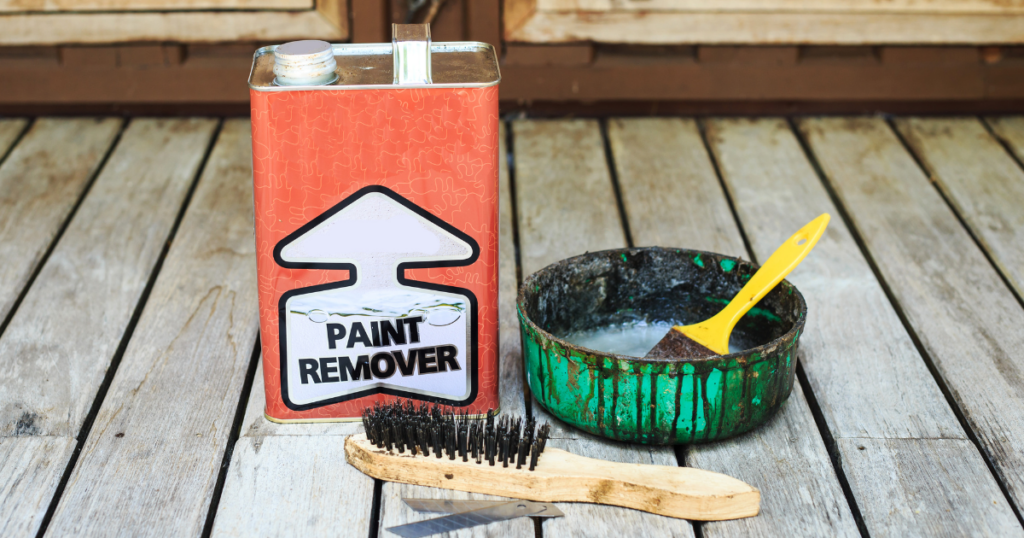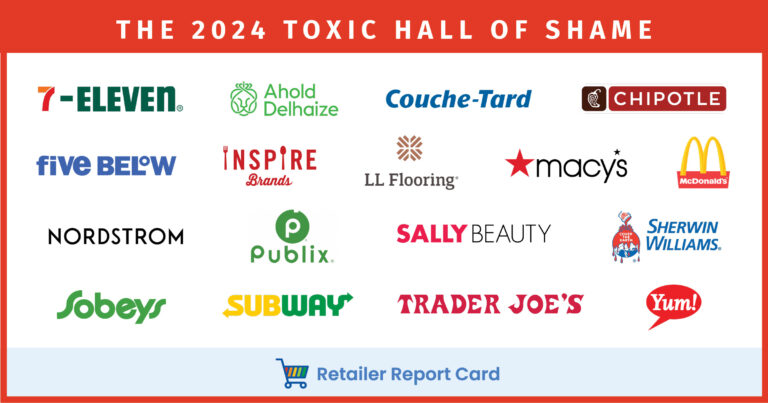Methylene Chloride
What is methylene chloride?
Methylene chloride, also known as dichloromethane or DCM, is a solvent used in paint strippers and other products. It has been linked to cancer, cognitive impairment, and immediate death by asphyxiation. If you need to remove paint or a coating, make sure to avoid products containing methylene chloride and other toxic chemicals like N-methylpyrrolidone (NMP). For more information, see our list of safer products.

How am I exposed to methylene chloride?
If you use products with methylene chloride, you may be exposed by inhaling the fumes of the chemical. It’s also possible for this chemical to be absorbed through skin.
- Paint Strippers: Methylene chloride is a key ingredient in a variety of paint strippers sold in the U.S. Many methylene chloride-based paint and coating removers are used in areas with limited ventilation such as bathrooms, allowing fumes to build up. Methylene chloride vapor is heavier than air, so it concentrates low to the ground, right around the level where a person stripping a surface like a bathtub is breathing.
- Adhesives: This chemical is also used in a range of adhesives, such as acrylic cement for hobbyists. For more information, you can view a comprehensive list of adhesives containing methylene chloride developed by EPA (see pages 7-10).
- Other Products: Other products containing DCM are used for automotive care, lubrication, lithography, and general cleaning, according to EPA’s list of methylene chloride products.
- Keep in mind: According to EPA, respiratory protection may not be enough to protect people from being exposed where levels of methylene chloride are high.
Even those who aren’t directly using the product could be exposed to the chemical.
- Children: Children and other occupants present in homes where methylene chloride is used for paint removal may be exposed during the removal even if kept away from the work area. If the work area has limited ventilation, methylene chloride fumes may linger for several hours and children may be exposed during this time if they return to the work area (e.g., a bathroom). This risk may extend to children or others living in apartments or in hotel rooms next to units where paint is being removed.
- Developing fetuses: Pregnant women working with methylene chloride risk exposing their fetus to the chemical.
- Workers: Even if you aren’t using the chemical itself, if you enter an area where it was used recently or disposed of, you may be exposed.
Why should I be concerned?
Short (“acute”) exposures can cause death by heart attack or asphyxiation.
- Methylene chloride turns into carbon monoxide in the body and can cut off the oxygen supply to the heart. At high doses, the chemical switches off the breathing center of the victim’s brain.
- To learn more about this type of exposure, view this video about the events that led to the death of a professional bathtub refinisher who was stripping a bathtub with methylene chloride.
- To learn more about how common this type of exposure is, view our map of known U.S. deaths from methylene chloride exposure from 1980 to 2018.
- Other nervous system effects range from sensory impairment to loss of consciousness. Learn more in this video that includes a first-hand description from someone who experienced acute methylene chloride exposure and survived.
- In particular for fetuses: since their hemoglobin has a higher affinity for carbon monoxide than adult hemoglobin, these nervous system effects may be exacerbated when fetuses are exposed to high concentrations of DCM.
Long-term (“chronic”) exposures have been linked to:
- Nervous system effects such as cognitive impairment, effects on attention
- Cancer of the liver, brain, and lung, as well as non-Hodgkin’s lymphoma or multiple myeloma
- Liver toxicity
- Kidney toxicity
- Reproductive toxicity
How can I reduce my exposure?
1. Know the ingredients in your paint stripper or other products listed above
- To identify ingredients, you may have to find the product’s material safety data sheet (MSDS).
- If you or your home contractor needs to remove paint or a coating, make sure the product used does not contain methylene chloride.
- Even if you are in a different room while the work is going on—or if the work was completed in a poorly ventilated room and you use it just a few hours after the project—you may still be at risk.
- Companies have commonly substituted methylene chloride with another toxic chemical: N-methylpyrrolidone (NMP). It’s also important to avoid products containing this chemical.
2. Look for safer products
- Check our list of safer alternatives for paint and varnish strippers and graffiti, stain, spill, and all-purpose removers that do not contain methylene chlroide or NMP and are sold by major U.S. retailers (updated December 2019).
- Additional safer alternatives are under development: watch this video to find out more.
- For more detailed information on safer alternatives, see reports by Clean Production Action and the Toxics Use Reduction Institute (TURI).
3. Use another method without chemicals—although it may carry different risks
- Other paint and coating removal methods include sanding, thermal removal, hydroblasting, abrasive blasting, laser removal, and infrared removal.
What’s the solution?
It is impossible for us to shop our way out of this problem. And we shouldn’t have to. When you walk into a store, you should be able to trust that the products on store shelves are safe.
Companies shouldn’t sell products with dangerous chemicals—especially as scientists continue to learn more about the “silent epidemic” caused by the cumulative impact of all the toxic chemicals we are regularly exposed to. And our state and federal governments shouldn’t allow chemicals on the market until they’re proven safe.
The only way to protect everyone from toxic chemicals like methylene chloride is to change policies at government and corporate levels to make sure that safer solutions are the norm.
We’re fighting every day to protect you and your loved ones from toxic chemicals like this. To join our fight, please consider making a donation, taking action with us, or signing up for our email list.
Our Key Projects & Priorities
Take Action

